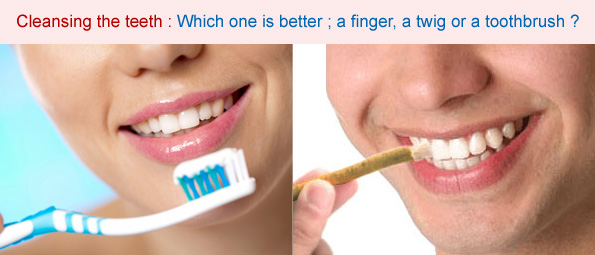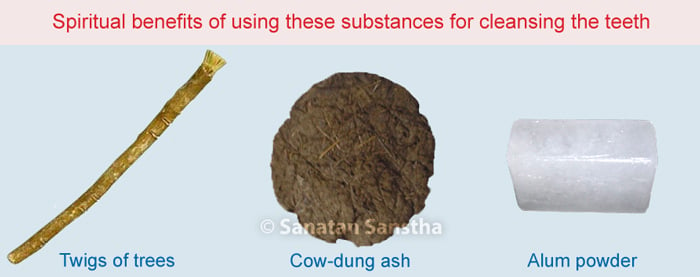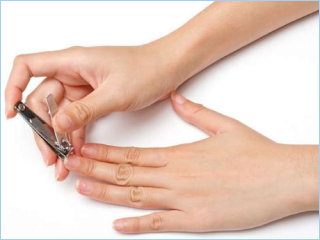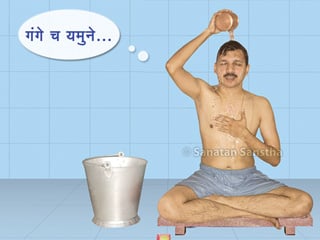
In the following article, we will discuss how even such a simple act as cleansing the teeth has profound spiritual significance when it is performed methodically as prescribed by the scriptures. Let us understand the process step by step.
1. Praying to the cleansing substance
Pray to the substance used for cleansing the teeth, as given ahead.
आयुर्बलं यशो वर्च: प्रजा: पशून् वसूनि च ।
ब्रह्म प्रज्ञां च मेधां च त्वं नो देहि वनस्पते ।।
Meaning : Bless me with a long life, strength, success, radiance, subjects, animals, wealth, Brahman (God Principle), intellect and the power to comprehend.
(This is the great Hindu Dharma, one that teaches offering of gratitude also towards a plant useful in cleansing the teeth, and thereby perceiving divinity in it ! – Compiler)
2. Which substances should be used and
which should be avoided in cleansing the teeth ?
A. Using twigs of trees like Neem,
Khair (Cutch tree), Karanj, Audumbar for cleansing the teeth

What is the underlying spiritual science in using twigs for tooth cleansing ?
Cleansing the teeth with a twig of Neem, Audumbar etc. disintegrates the Raja-Tama predominant waves on the teeth, facilitating the generation of pure gases in the mouth. These beneficial gases gradually spread in the voids of the body and provide the voids within the body with energy to continue the day’s activities.
Using cow-dung ash or powder of alum for cleansing the teeth
Let us understand the science underlying this practice
Teeth are predominantly a blend of the Pruthvi-tattva (Absolute Earth Principle) and the Apa-tattva (Absolute Water Principle).
1. Food collected in the spaces between the teeth during the process of eating, create Raja-Tama-predominant foul odour over a time, making the atmosphere within the void of the mouth impure.
2. Why Cow-dung ash ?
Ash made from burning dried cow-dung contains gases that have fragrance akin to that of Tej-tattva (Absolute Fire Principle). Cleansing the teeth by forceful rubbing of this ash onto the teeth disintegrates the Raja-Tama-predominant and odorous waves within the void of the mouth, and thus helps in retaining the purity of the mouth.
3. Rinsing the mouth thoroughly with water thereafter dissolves the remaining harmful waves and gases in the mouth, thus purifying it completely.
The effectiveness of Alum in tooth cleansing
1. Fragrant gas having momentum and associated with the friction related Tej-tattva is concealed in alum. Applying alum helps in concentration of both, the Raja-Tama-predominant waves and waste gases in the teeth, in the void of the mouth.
2. The concentrated atmosphere formed at the level of Tej indicating the disintegration process of Raja-Tama-predominant waves, gets washed away because of the rinsing of the mouth with water.
3. Thus, along with the teeth, it helps cleanse the void of the mouth as well. Cow-dung ash prepared by burning cow-dung is more beneficial than alum.
3. To cleanse the teeth based on the tridosh (Three defects)
and trigun (Three components), use a twig of a tree, cow-dung ash or alum
Compiler
It is recommended that the teeth be cleansed with a twig of a tree, cow-dung or alum. Should the substance used for cleansing be changed everyday ?
A Scholar
No. Use the substance that matches your Prakruti (Constitution).
A. Tridosh
Depending on whether Vata ( Wind ), Kapha ( Phlegm ) or Pitta ( Bile ) is the predominant factor of the constitution, use a twig, cow-dung ash or alum respectively.
B. Trigun
In terms of the Principle, it is appropriate that Sattvik, Rajasik and Tamasik individuals use a twig, cow-dung ash or alum respectively.
Use a powder prepared by mixing
various Ayurvedic medicines for cleansing the teeth
Do not brush the teeth with the twig of the tendu tree
Underlying science
The Tendu (Ebony-Diospyros melanoxylon) twig is tamasik; hence, using it to cleanse the teeth is prohibited.
Method of cleansing the teeth
1. Cleansing the teeth in the squatting posture or standing in one place
The teeth get cleansed properly if cleansing is done by squatting or standing in one place. Hence, do not cleanse them while walking about.
2. Why is cleansing the teeth with fingers better than cleansing them with a toothbrush ?
A. The body feels more closeness to its finger, than it does to a lifeless toothbrush.
B. A toothbrush only cleans the teeth and removes the food particles collected between the teeth. However, it has no effect on the gums from where the teeth originate. The healthier the gums, the higher are the chances of the teeth remaining healthy.
C. A finger, along with cleansing the teeth, automatically massages the gums and enhances their health. The Apa-tattva is subtler than the Pruthvi-tattva and hence, more effective.
D. So, taking care of the Apa-tattva predominant gums together with cleansing is more important than merely taking care of the Pruthvi-tattva predominant teeth.
3. Physical and psychological benefit obtained on
cleansing the teeth with a finger or a twig, instead of a toothbrush
Bristles of a toothbrush are artificial. They emit Raja-Tama-predominant particles. Contact of these bristles with the teeth and gums causes a covering of Raja-Tama-predominant waves to form around them. Thus, the teeth are cleansed only at the gross level; but at the subtle level, they remain impure. Cleansing the teeth with a finger helps transmit energy from the body to the gums through the finger. Thus, the gums and teeth benefit from Sattvikta and are cleansed at the gross as well as the subtle levels.
A. Pressure of the finger on the gums amounts to massaging them. It helps in strengthening the gums.
B. When twigs of the Neem tree are used for cleansing, in addition to better cleansing of the teeth, the teeth and gums get the benefit of the juice and Chaitanya (Divine consciousness) in Neem, and get strengthened.
4. Which finger should be used for cleansing the teeth ?
The method as explained in the text Acharendu –
अनामाङ्गुष्ङ्गावुत्तमौ ।
मध्यमायाः कनिष्ङ्गिकायाश्च विहितप्रतिषिद्धत्वाद् विकल्पः ।
तर्जनी तु सर्वमते निन्द्या । – Acharendu
Meaning : It is correct to use the ring finger and thumb to apply the toothpowder. Using the middle finger or the little finger is optional, because certain schools of thought prohibit it. However, all prohibit using the index finger.
A. Use the ring finger while cleansing the outer surface of teeth. If this is not possible for any reason, then use the middle or little finger.
B. Use the thumb while cleansing the inner surface of teeth.
5. Spiritual explanation of the cleansing process
While cleansing the teeth on the outer surface with the middle finger using an Ayurvedic tooth powder, disintegration of the Raja-Tama predominant particles in the gums and voids of the teeth occurs due to the Tej-tattva emitted by the middle finger, along with that generated from the friction.



 Nine benefits of waking up at the Brahmamuhurt
Nine benefits of waking up at the Brahmamuhurt How to plan your day effectively?
How to plan your day effectively? Astrological viewpoint : On which days should nails be cut?
Astrological viewpoint : On which days should nails be cut? Varsha Rutucharya – a key to remaining healthy during the rainy season
Varsha Rutucharya – a key to remaining healthy during the rainy season Actions required to be performed after cleansing the teeth
Actions required to be performed after cleansing the teeth Prayer to be recited before a bathand shlokas to be recited while bathing
Prayer to be recited before a bathand shlokas to be recited while bathing
Thank You for this most interesting and beneficial information 🙏